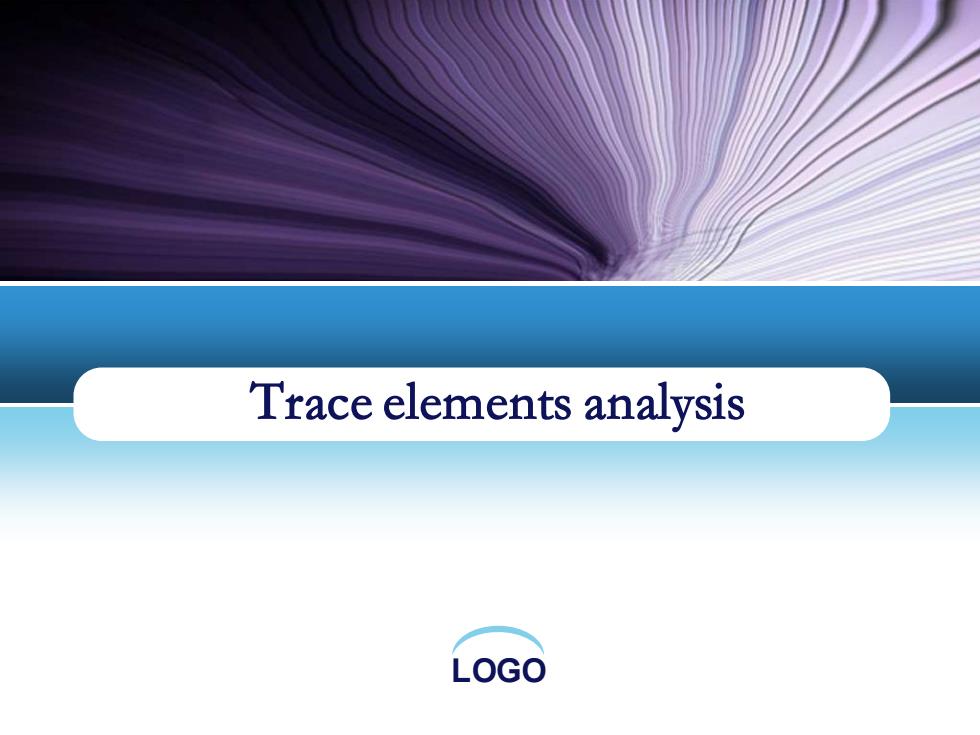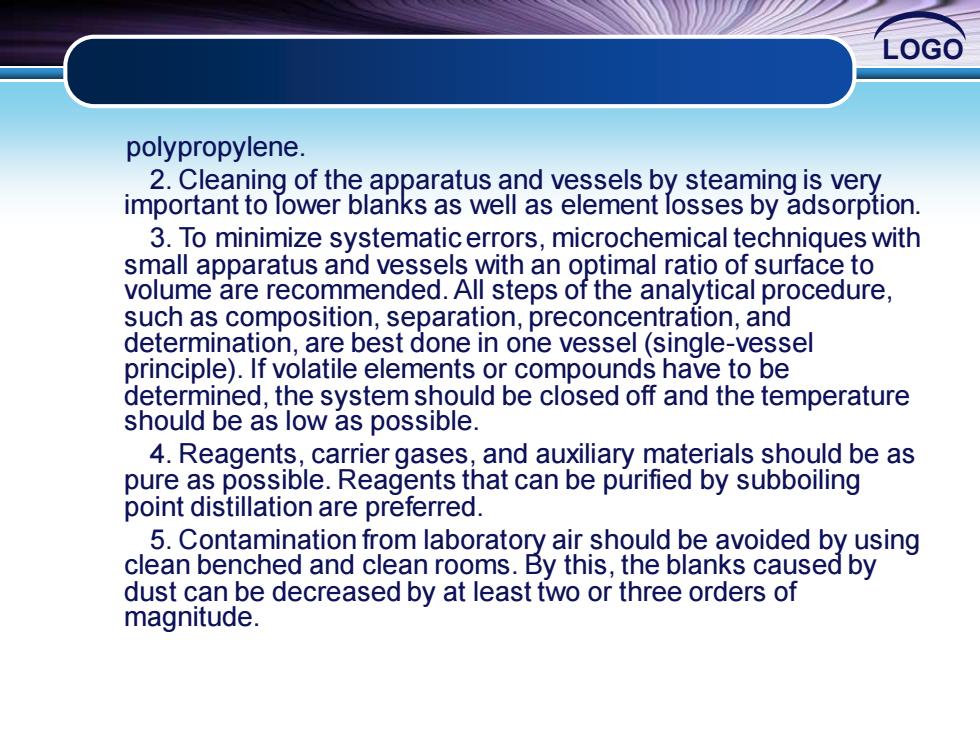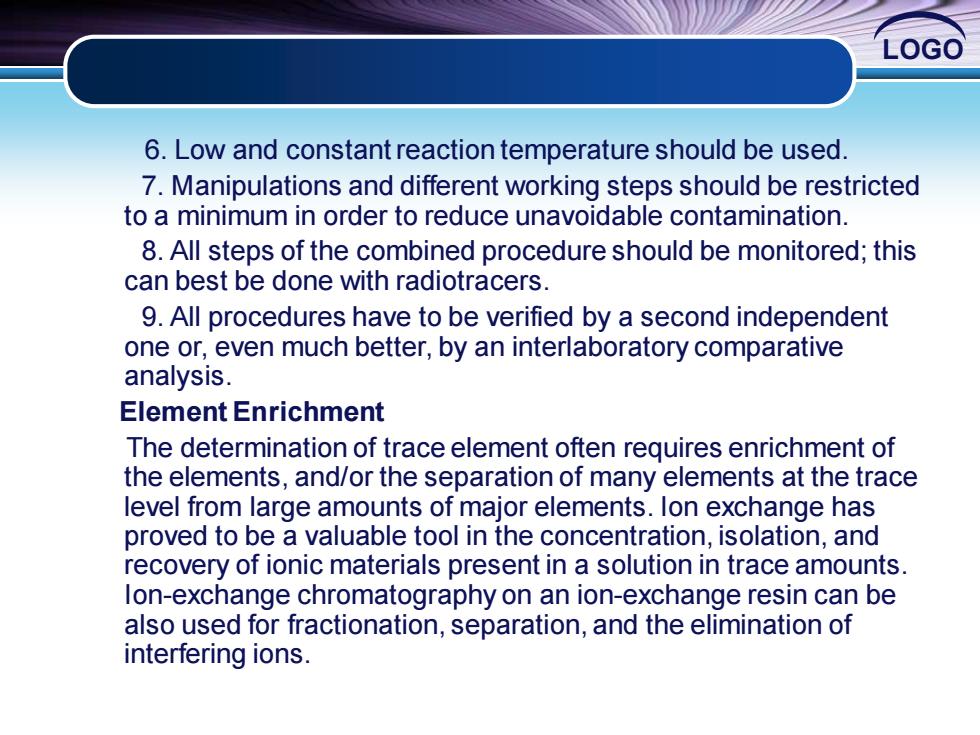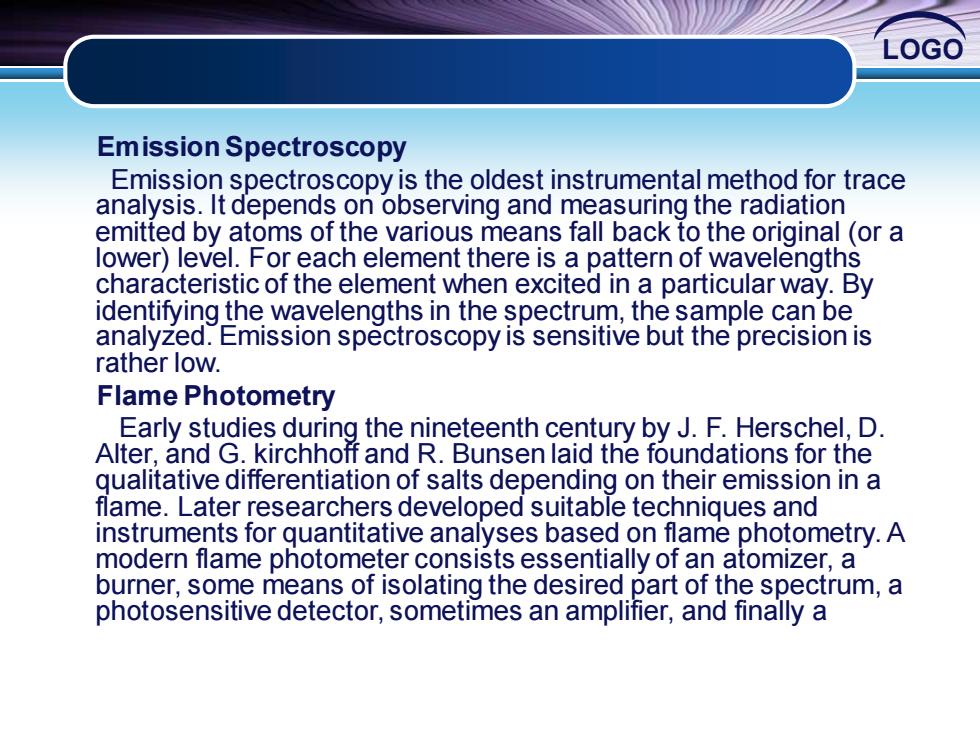
Trace elements analysis LOGO
LOGO Trace elements analysis

LOGO Elemental Analysis This chapter includes no detailed description of methods to determine individual mineral components.Such procedures are described in general textbooks of inorganic analysis,standard reference books on food analysis,and specialized textbooks on the determination of minerals in biological materials.The principles of instrumental methods used in the determination of mineral components and trace elements also were descried in previous chapters of this book.This chapter is primarily concerned with the applications of those principles to food analysis. Developments in the measurement of trace metal components in foods were described by LaFluer(1976),Winefordner(1976). Bratter and Schramel(1980),Das(1983),Schwedt (1984),and Benton-Jones(1984).Tshopel and Tolg(1982)reviewed the basic rules that have to be followed in trace analyses to obtain precise and accurate results at the nanogram and pictogram levels.These rules are as follows: 1.All materials used for apparatus and tools must be as pure and inert as possible.These requirements are only approximately met by quartz,platinum,glassy carbon,and,to a lesser degree
LOGO Elemental Analysis This chapter includes no detailed description of methods to determine individual mineral components. Such procedures are described in general textbooks of inorganic analysis, standard reference books on food analysis, and specialized textbooks on the determination of minerals in biological materials. The principles of instrumental methods used in the determination of mineral components and trace elements also were descried in previous chapters of this book. This chapter is primarily concerned with the applications of those principles to food analysis. Developments in the measurement of trace metal components in foods were described by LaFluer (1976), Winefordner (1976), Bratter and Schramel (1980), Das (1983), Schwedt (1984), and Benton-Jones (1984). Tshopel and Tolg (1982) reviewed the basic rules that have to be followed in trace analyses to obtain precise and accurate results at the nanogram and pictogram levels. These rules are as follows: 1. All materials used for apparatus and tools must be as pure and inert as possible. These requirements are only approximately met by quartz, platinum, glassy carbon, and, to a lesser degree

LOGO polypropylene. 2.Cleaning of the apparatus and vessels by steaming is very important to Tower blanks as well as element losses by adsorption. 3.To minimize systematic errors,microchemical techniques with small apparatus and vessels with an optimal ratio of surface to volume'are recommended.All steps of the analytical procedure, such as composition,separation,preconcentration,and determination,are best done in one vessel (single-vessel principle).If volatile elements or compounds have to be determined,the system should be closed off and the temperature should be as low as possible. 4.Reagents,carrier gases,and auxiliary materials should be as pure as possible.Reagents that can be purified by subboiling point distillation are preferred. 5.Contamination from laboratory air should be avoided by using clean benched and clean rooms.By this,the blanks caused by dust can be decreased by at least two or three orders of magnitude
LOGO polypropylene. 2. Cleaning of the apparatus and vessels by steaming is very important to lower blanks as well as element losses by adsorption. 3. To minimize systematic errors, microchemical techniques with small apparatus and vessels with an optimal ratio of surface to volume are recommended. All steps of the analytical procedure, such as composition, separation, preconcentration, and determination, are best done in one vessel (single-vessel principle). If volatile elements or compounds have to be determined, the system should be closed off and the temperature should be as low as possible. 4. Reagents, carrier gases, and auxiliary materials should be as pure as possible. Reagents that can be purified by subboiling point distillation are preferred. 5. Contamination from laboratory air should be avoided by using clean benched and clean rooms. By this, the blanks caused by dust can be decreased by at least two or three orders of magnitude

LOGO 6.Low and constant reaction temperature should be used. 7.Manipulations and different working steps should be restricted to a minimum in order to reduce unavoidable contamination. 8.All steps of the combined procedure should be monitored;this can best be done with radiotracers. 9.All procedures have to be verified by a second independent one or,even much better,by an interlaboratory comparative analysis. Element Enrichment The determination of trace element often requires enrichment of the elements,and/or the separation of many elements at the trace level from large amounts of major elements.lon exchange has proved to be a valuable tool in the concentration,isolation,and recovery of ionic materials present in a solution in trace amounts. lon-exchange chromatography on an ion-exchange resin can be also used for fractionation,separation,and the elimination of interfering ions
LOGO 6. Low and constant reaction temperature should be used. 7. Manipulations and different working steps should be restricted to a minimum in order to reduce unavoidable contamination. 8. All steps of the combined procedure should be monitored; this can best be done with radiotracers. 9. All procedures have to be verified by a second independent one or, even much better, by an interlaboratory comparative analysis. Element Enrichment The determination of trace element often requires enrichment of the elements, and/or the separation of many elements at the trace level from large amounts of major elements. Ion exchange has proved to be a valuable tool in the concentration, isolation, and recovery of ionic materials present in a solution in trace amounts. Ion-exchange chromatography on an ion-exchange resin can be also used for fractionation, separation, and the elimination of interfering ions

LOGO Emission Spectroscopy Emission spectroscopy is the oldest instrumental method for trace analysis.It depends on observing and measuring the radiation emitted by atoms of the various means fall back to the original (or a lower)level.For each element there is a pattern of wavelengths characteristic of the element when excited in a particular way.By identifying the wavelengths in the spectrum,the sample can be analyzed.Emission spectroscopy is sensitive but the precision is rather low. Flame Photometry Early studies during the nineteenth century by J.F.Herschel,D Alter,and G.kirchhoff and R.Bunsen laid the foundations for the qualitative differentiation of salts depending on their emission in a flame.Later researchers developed suitable techniques and instruments for quantitative analyses based on flame photometry.A modern flame photometer consists essentially of an atomizer,a burner,some means of isolating the desired part of the spectrum,a photosensitive detector,sometimes an amplifier,and finally a
LOGO Emission Spectroscopy Emission spectroscopy is the oldest instrumental method for trace analysis. It depends on observing and measuring the radiation emitted by atoms of the various means fall back to the original (or a lower) level. For each element there is a pattern of wavelengths characteristic of the element when excited in a particular way. By identifying the wavelengths in the spectrum, the sample can be analyzed. Emission spectroscopy is sensitive but the precision is rather low. Flame Photometry Early studies during the nineteenth century by J. F. Herschel, D. Alter, and G. kirchhoff and R. Bunsen laid the foundations for the qualitative differentiation of salts depending on their emission in a flame. Later researchers developed suitable techniques and instruments for quantitative analyses based on flame photometry. A modern flame photometer consists essentially of an atomizer, a burner, some means of isolating the desired part of the spectrum, a photosensitive detector, sometimes an amplifier, and finally a